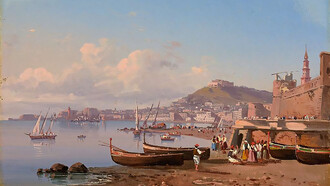"The train came out of the long tunnel into the snow country. The earth lay white under the night sky".
The first opening lines in Japanese Nobel prize literary master, Yasunari Kawabata’s much celebrated novel Yukiguni (Snow Country) transport you about 200 kilometers northwest of Tokyo to the heart of the Japan Alps in the quaint, snow-filled town of Yuzawa in Niigata Prefecture. Here, where abundant patches of white envelope the quiet mountain ranges, and traditional “ryokans” (inns) profusely scatter among flowing “onsens” (hot springs), Kawabata scribbled Snow Country, ardently inspired by the joys and trials of rural life in this sheltered, remote village.
Kawabata’s original writing nook can be viewed at the Takahan Ryokan that has a history of over 800 years. Only about ten minutes by car from Echigo-Yuzawa station, the traditional-styled inn houses a small museum that displays the writer’s literary works, documents, writing desk, and the room where he stayed, with a beautiful inner stone garden opening to the white visions of the snow country. There is a cozy library hall, filled with books on literature, history and culture of the region. Its “onsen” bath boasts of fresh, unsterilized natural hot spring water that incessantly flows into the pools; a “rotemburo” (outdoor hot bath) that astoundingly reveals a spectacular view of the rising pine trees and the frolicking snow that sprinkles on the branches like icing. On a snow-blanketed day, stepping out of the inn leads you to a hill that mirrors the vast whiteness of the mountainous landscape. Many travelers have held their breath with wonder, standing before this magical scenery. One clearly understands how Kawabata had chosen this particular niche as a reclusive, inspirational haven to complete his highly acclaimed novel.
Yuzawa, together with Uonuma, Tokamachi, and Tsunan in Niigata Prefecture, is well reputed for having some of the heaviest snowfall in Japan, reaching up to six meters. Despite the harshness of the climate, the town folks have adapted dauntlessly to a slow, wintery life. Whereas farmhouses of the past were built with thatched roofs to survive the thick snowfall, in present times, the roofs are built in a steep degree so snow could conveniently slide down. They are also warmed with heating oil or solar batteries for snow to melt quickly. For years, the people of these towns have learned to carry on with their day-to-day chores arduously with patience, endurance and fortitude.
Ski resorts, therefore, abound, ranging from huge competition resorts, such as the Naeba resort, to small, intimate family ones, such as the Matsuda Station in Tokamachi. Many of the ski resorts are conveniently located adjacent to the train stations and hotels, making them therefore, an easy hop to the slopes. When traveling by train, and not by car, some visitors prefer to arrive with as little baggage as possible, since some of the resorts, such as the Gala Yuzawa, are fully equipped with ski wear and gear, snowboards, and all necessary ski accessories for rent.
A common Japanese practice for winter sports enthusiasts is to dip into the “onsen” hot springs spa and immerse themselves in deliciously brewed saké after a day of basking on powdered slopes. Yuzawa is home to many charming, traditional “ryokan” inns where one can gaily enjoy the splendid, warm hot baths, not just in winter, but any time of the year. Kawabata’s Snow Country depicts this culture when Shimamura, the lead character, a writer and critic heads to this snow region from Tokyo by train in the 1930s to meet the young hot springs geisha, Komako, whom he falls in love with. The stark relation between the novel and the grey surroundings of the local town brings to life the sensitive, brushstroke imagery of the silent nature, poetry of the waters, and surreal dampness of the cold as two characters intertwine in a play of undefined romance and indolence. The novel not only captures the town’s picturesque settings, but also scrutinizes the behavioral characteristics of those times between the less inhibited laid-back country village folks and anxious, but constrained travelers from the modern city.
It is often said that in Japan, during the olden times, a trip to the hot spas was frequented by unaccompanied gentlemen. And, every hot spa had its geisha and inn maids. The hot springs geisha, as how Komako is portrayed in Snow Country, was generally intelligent, sensitive, and pure-hearted, and had to persistently entertain the city traveler every weekend with guided song, dance, the flirtatious serving of saké and deep conversation, sometimes, persuading the man to open a business for her, or coerce him into marriage. The fact that she possibly wandered from one “onsen” to another gave her aura a tinge of sad beauty, trapped in poignant encounters that were often temporal, troubled, and tragic.
There is, therefore, an unwavering notion of crisp melancholy when walking along the damp streets of Yuzawa, as though the tiny sounds of the geisha’s wooden “geta” clogs and the swooshing rhythm of her smooth, silk-lined kimono still sway with a lingering calling. Today, there are no longer geishas in such villages, and the rustic sceneries have been transformed into touristic getaways for couples and families to savor short vacations. Still, the nostalgic ambience of the hot springs and the thick snow-covered hills easily lift a traveler’s spirit into a dream bathed in subtle contemplation as one gazes yearningly at the white, cotton-filled trees and misty, immaculate skies.
As Kawabata wrote in Snow Country:
“In the depths of the mirror the evening landscape moved by, the mirror and the reflected figures like motion pictures superimposed one on the other. The figures and the background were unrelated, and yet the figures, transparent and intangible, and the background, dim in the gathering darkness, melted together into a sort of symbolic world not of this world. Particularly when a light out in the mountains shone in the center of the girl’s face, Shimamura felt his chest rise at the inexpressible beauty of it.”














